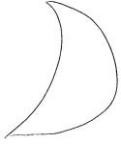by Jeff Hutton
Did you notice how big the full moon was before clouds closed in on April 8? Maybe you heard someone call it the “Super Moon”. If you’d like to learn more about that, read this month’s “The Skies over the Pinnacles” or go to NASA’s website at www.NASA.gov and type in “Super Moon” in the Search Box. The moon always seems to be changing its shape doesn’t it? You might have also heard terms like “New Moon” or “First Quarter Moon”. Curious? Read on!
The earth and the moon are linked by gravity and the moon revolves around the earth once every 29 ½ earth days or about every month. (The word ‘month’ comes from the word ‘moonth’ but nobody says ‘moonth’, anymore.) All of the “stuff” in the solar system (planets, moons, asteroids, whatever) are lit by the sun so when we see our moon or, say, Venus, we are seeing sunlight reflecting off that object.
TRY THIS: Grab a baseball, soccer ball or any ball and go outside on a sunny day. Look at the part of the ball that is lit by sunlight. How much of the ball is reflecting sunlight? How much is in shadow? If you think that half of the ball is always lit by sunlight and half is in shadow, you would be right!
THINK ABOUT THIS: If that ball were really the moon, what part of the day would it be on the side lit by the sun? What would you call the part of the “moon” that is in the shade? What about if the ball were really the earth?
If you asked your friends to draw a picture of the moon would they come up with something that looks
like this? Or this?


TRY THIS: Look at the “Lunar Photographs – Set #1 and print 2 copies. These are pictures of some of the ‘phases’ or shapes the moon shows throughout the “moonth”. From one of printed copies follow the instructions and carefully cut out each picture and arrange them in the order that the moon seems to change shape over one ‘moonth’. (Hint: the two shapes that look like picture #1 above go on either end facing away from each other.) Tape or glue the 6 moon pictures down to a sheet of printer paper in the order you think they should go. This is your first “Moon Phase Chart. Save this for later.
TRY THIS: During the next month, look at the moon on every clear night you can. Can you match up
your moon pictures to the way the moon looks in the sky that night? The next best dates to match up
these pictures will be around:
April 11 (after midnight)
April 16 (just before sunrise)
April 27 (in the evening)
April 30 (in the evening)
May 3 (in the evening)
May 8 (in the evening)
When you see the moon near these dates, try to match a picture from your second of pictures to the
real moon in the sky Make a second chart, using the moon in the sky as your guide and match your
second set of printed moon pictures to the real moon. Did your first moon phase chart match your
second moon phase chart?
(Hint: Look carefully at the patterns on the moon pictures to help you turn the image right side-up!) In
each picture. which part of the moon is having daytime? Which part is having night?

https://astrosociety.org/
For a printable PDF click HERE.

0 Comments